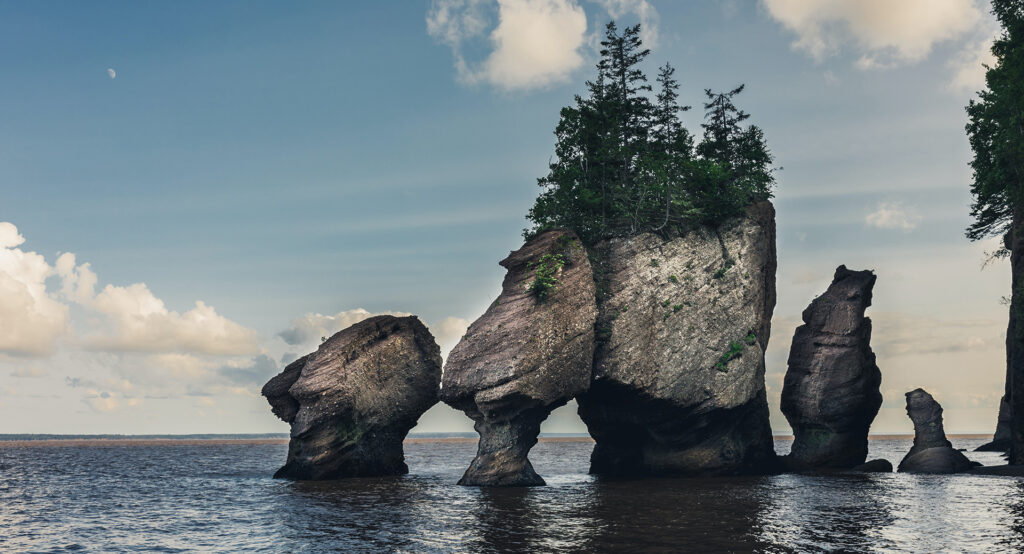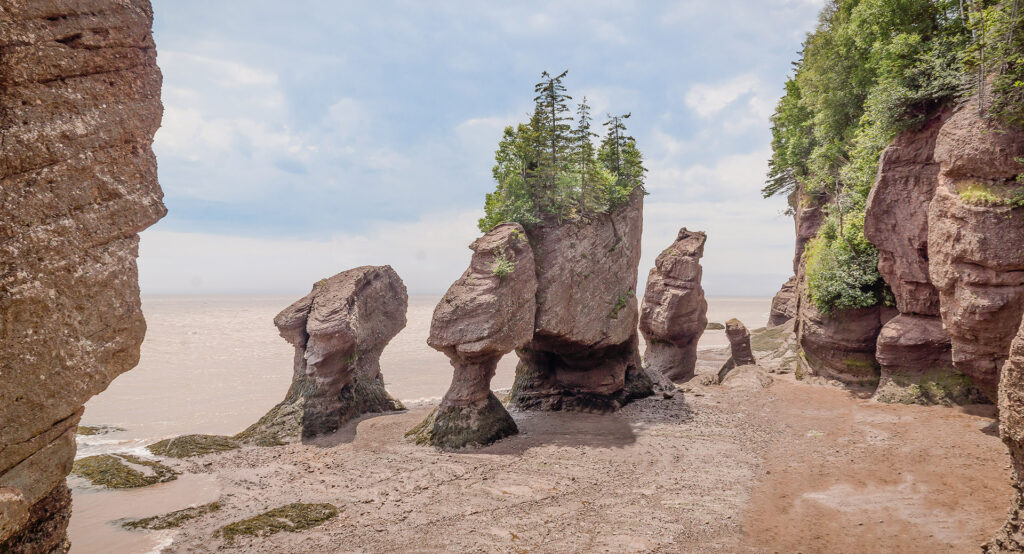15 Fascinating Facts About the Bay of Fundy
Welcome to the Bay of Fundy, a stunning natural wonder located between the Canadian provinces of New Brunswick and Nova Scotia. With its towering cliffs, rugged coastline, and unique tidal phenomena, the Bay of Fundy is a must-visit destination for any nature lover. In this post, we’ll explore 15 fascinating facts about this incredible place, from its record-breaking tides to its diverse wildlife and rich cultural heritage. So sit back, relax, and get ready to be amazed by the wonders of the Bay of Fundy!
The Bay of Fundy is located on the east coast of Canada, between the provinces of New Brunswick and Nova Scotia.
1 It is known for having the highest tides in the world, with tidal ranges that can exceed 16 meters (52 feet) in some places. The Bay of Fundy is also home to unique and diverse marine ecosystems, including several endangered species.
It is known for having the highest tidal range in the world, with tides that can reach up to 16 meters (52 feet) in height.
2 This is due to a combination of factors, including the bay’s unique shape, the gravitational pull of the moon and the sun, and the effects of resonance and amplification within the bay.
The extreme tidal range has also created a unique ecosystem in the bay, with diverse and abundant marine life that has adapted to the changing tides.
The Bay of Fundy is approximately 270 km (170 miles) long, but its width varies more than the stated range.
3 At its mouth, the bay is approximately 80 km (50 miles) wide, but it narrows to less than 50 km (31 miles) wide in some areas, and it can be as narrow as 16 km (10 miles) at its most constricted point, near the northern end of the bay.
The bay also has a number of large inlets and bays, including the Minas Basin, Chignecto Bay, and Passamaquoddy Bay, which further affect its size and shape.
The name “Fundy” is believed to have come from the French word “Fendu,” which means “split” or “divided.”
4 This name was likely given to the Bay of Fundy due to the bay’s many channels, passages, and inlets, which create a highly complex and intricate coastline.
The Bay of Fundy is located on the east coast of North America, between the Canadian provinces of New Brunswick and Nova Scotia, and is known for having some of the highest tides in the world.
The Bay of Fundy is home to several species of whales, including humpback, minke, and fin whales.
5 These magnificent creatures can often be spotted breaching and feeding near the surface of the water, making the bay a popular destination for whale watching tours. In addition to whales, the bay is also home to a diverse array of other marine life, including seals, dolphins, porpoises, and a variety of fish species.
The Bay of Fundy’s unique ecosystem and diverse wildlife make it an important area for scientific research and conservation efforts.
The unique tidal conditions of the Bay of Fundy have created a rich ecosystem that supports a wide variety of marine life, including lobster, scallops, clams, and salmon.
6 The bay’s extreme tides, which can reach up to 50 feet (15 meters) in some areas, create nutrient-rich conditions that support the growth of phytoplankton, the foundation of the bay’s food chain.
This, in turn, supports a diverse array of marine life, from tiny zooplankton to large predators like sharks and whales. The bay is also an important area for commercial fishing, with many local communities relying on the bay’s resources for their livelihoods.
The Bay of Fundy is an important stopover point for migratory birds, with over 300 species passing through the area each year.
7 The bay’s rich ecosystem, which includes mudflats, salt marshes, and forests, provides an ideal habitat for a diverse range of bird species. Some of the birds that can be spotted in the area include sandpipers, plovers, eagles, ospreys, and many species of waterfowl.
The bay is also home to several important bird sanctuaries and conservation areas, which are dedicated to protecting the area’s avian inhabitants.
The Hopewell Rocks, located on the New Brunswick side of the Bay of Fundy, are a popular tourist attraction.
8 They feature uniquely shaped rock formations that have been eroded by the tides over millions of years. The rocks are located in the Hopewell Rocks Ocean Tidal Exploration Site, which is part of the larger Fundy National Park.
Visitors to the site can explore the rock formations at low tide, walking along the ocean floor and admiring the towering cliffs and pillars. At high tide, the area is transformed as the water rises and covers much of the beach, leaving only the tops of the rocks exposed.
The Hopewell Rocks are one of the most popular destinations in the Bay of Fundy region, attracting thousands of visitors each year.
The Bay of Fundy is home to several historic lighthouses, many of which have been in operation since the 19th century.
9 These lighthouses were once crucial navigational aids for ships navigating the treacherous waters of the bay, which are known for their rocky coastlines and strong tides.
Some of the most well-known lighthouses in the area include the Cape d’Or Lighthouse in Nova Scotia, which dates back to 1922, and the West Quoddy Head Lighthouse in Maine, which was first lit in 1808 and is the easternmost point in the United States. Today, many of these lighthouses have been restored and are open to visitors, offering a glimpse into the region’s maritime history and providing stunning views of the bay and surrounding coastline.
The Bay of Fundy is known for its tidal bore, a unique phenomenon where incoming tides create a wave that travels upstream against the current of rivers and streams that flow into the bay.
10 This creates a powerful wave that can be several feet high and is popular with surfers and kayakers. The tidal bore can be seen at several locations along the bay, including the Shubenacadie River in Nova Scotia and the Petitcodiac River in New Brunswick.
Visitors to the area can watch the bore from viewing platforms or take part in guided tours that offer the opportunity to surf or kayak on the wave. The tidal bore is just one of the many natural wonders that make the Bay of Fundy a truly unique and exciting destination.
The Bay of Fundy has a long history of shipbuilding and fishing, dating back to the 17th century when European settlers first arrived in the area.
11 The region’s natural resources, including its rich fisheries and dense forests, made it an important center for shipbuilding and trade. Today, many communities along the bay’s shores still rely on these industries, with fishing and seafood processing being major employers in the region.
In addition to fishing, the bay is also a popular destination for recreational boating, sailing, and other water-based activities. The area’s maritime history and culture are an important part of its identity and continue to be celebrated and preserved by local communities and organizations.
The Bay of Fundy is known for its powerful tides and has been a hub for research and development in tidal energy for many years.
12 The region is home to several experimental tidal power projects, including the FORCE (Fundy Ocean Research Center for Energy) test site in Nova Scotia, which is a collaboration between the Canadian government and industry partners to develop and test new tidal energy technologies.
The bay’s strong and consistent tides make it an ideal location for testing and developing new tidal energy technologies, which have the potential to provide a clean and renewable source of electricity for coastal communities around the world.
In 2007, the Bay of Fundy was designated as a UNESCO Biosphere Reserve, recognizing its unique and diverse ecosystem, as well as its cultural heritage.
13 The reserve covers an area of over 4,000 square miles and includes a wide range of habitats, from rocky shores and salt marshes to forests and wetlands. The bay’s rich biodiversity and important cultural heritage make it a valuable resource for scientific research, education, and sustainable development.
The designation as a Biosphere Reserve also helps to promote conservation and responsible management of the bay’s natural resources, ensuring that future generations can continue to enjoy and benefit from this unique and important ecosystem.
The Bay of Fundy is known for its rich deposits of fossils, particularly from the Late Triassic and Early Jurassic periods, which spanned approximately 200 to 175 million years ago.
14 The area was once covered by a shallow sea, and over time, the remains of marine animals and plants became buried in sediment, eventually forming layers of rock. The powerful tides of the bay have eroded these rock formations over time, exposing the fossilized remains of ancient sea creatures, including dinosaurs, reptiles, and early mammals.
Some of the most important fossil discoveries in the region include the first complete dinosaur skeleton found in Canada, known as the Albertosaurus, and the oldest known dinosaur embryo fossils in the world. Today, the Bay of Fundy is a popular destination for fossil hunting and paleontological research, with several museums and interpretive centers dedicated to the area’s rich fossil heritage.
The Bay of Fundy is truly a natural wonder, attracting visitors from all over the world to experience its unique and diverse ecosystem, stunning scenery, and incredible tidal range.
15 From the towering cliffs and rock formations to the rich marine life and fascinating geological history, there is something for everyone to discover and enjoy in this beautiful and awe-inspiring region.
Whether you’re interested in outdoor adventure, wildlife watching, or simply soaking up the natural beauty of the area, the Bay of Fundy is a must-see destination that is sure to leave a lasting impression on all who visit.




